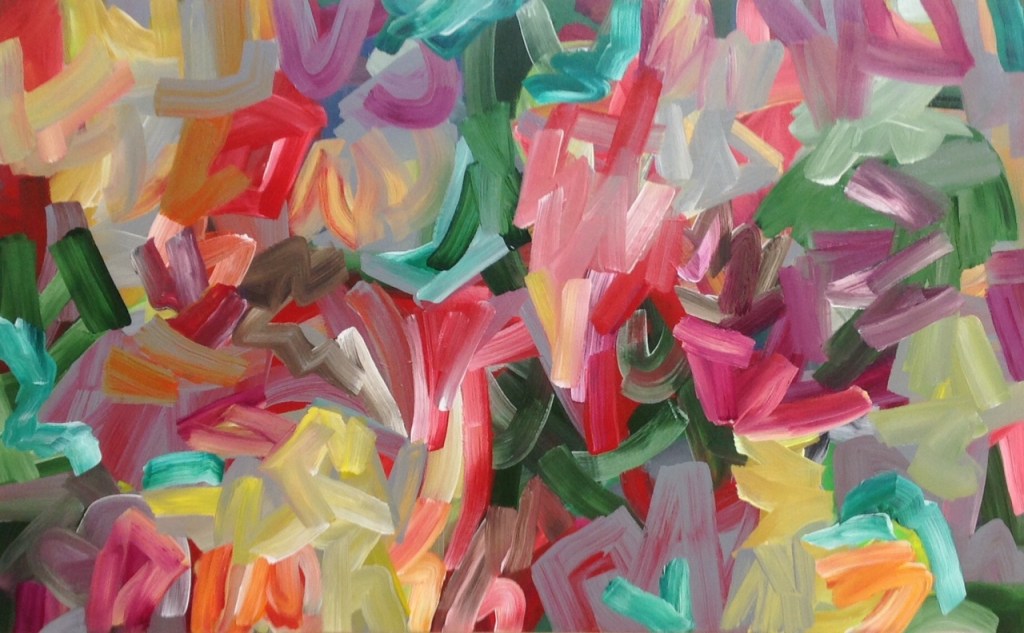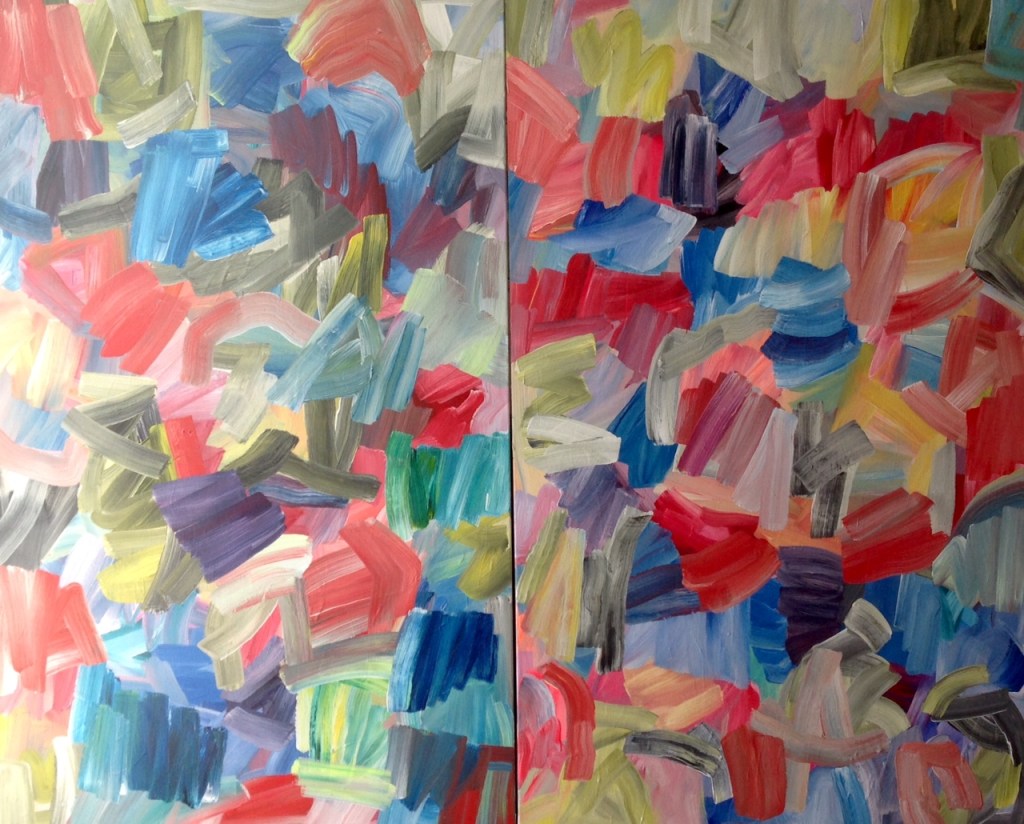Brancaster Chronicle No. 74: Noela James Bewry Paintings

21st July 2019, near Bath.
Taking part: Hilde Skilton, Mark Skilton, Anne Smart, Anthony Smart, Sarah Greenwood, Robin Greenwood, Charley Greenwood, Shelley Latham, Noela James, Steven Walker, John Pollard, Richard Ward





Noela’s characteristic, ribbon like marks create miles and miles of edges in each work. I think it is the treatment of these edges – the way the coloured areas come together and relate to each other – that gives each of these paintings at least one aspect of its particular character.
In no. 4 the marks crisscross and get in each other’s way, fighting like crabs in a bucket. There is no sense of communality or mutual respect. I exaggerate of course, but the eye has a bumpy ride, repeatedly held up by fractures and warring inconsistencies.
No. 3 is different and more peaceable because here Noela has created a whole lot more space between the marks. Particularly towards the upper and right hand sides of the painting, the overlapping areas of paint have air between them, existing as “individuals” in space. Without edges in common they are like pioneers moving out from a densely packed lower left corner into a generous vastness of virgin territory.
In no. 1 the marks are pressed together again into shallow space, but here they relate much more respectfully than in no. 4. Look at how the blues, reds, pinks and yellows combine in the upper left hand corner of the right hand panel. The edges are finely judged, allowing significance to each coloured area. Intrusions connect rather than eclipse or suppress.
That said, there is something a little rigid and formal in the relationships throughout this painting. The communality and respect seem here somewhat imposed, as at an over-polite tea-party.
All this loosens up, becoming organic and flexible in no. 5.
There is nothing forced here. Particularly on the left hand side, the coloured areas combine and disengage fluidly and without compulsion.
LikeLike
Thank you Richard, I really enjoy your insightful comments and descriptions. I get the ‘crabs in a bucket ‘ look of number four, the painting takes a while to connect with the rhythms within it.
I agree with what you said on film concerning one particular black mark on the nearly bottom right hand side, there is something a little too dominant about it.
I have actually completely altered number one and could get it posted if you are interested. I wasn’t happy with the reds and before long the whole painting changed.
LikeLike
Yes, that would be interesting. Maybe a better photo of no. 5 too? The light looks a bit uneven on it.
LikeLike
Will do Richard, I shall get the images to John sometime this weekend.
LikeLike
Noela has provided a new photo of no. 5 and a photo of reworked no. 1 (now no. 6).
LikeLike
Thank you John.
I felt the reds in the original painting were somewhat problematic for me but when I changed them it sent the whole image out of kilter and before long everything had to change.
I feel the updated version is more coherent.
LikeLike
Ps. I’m talking about the diptych.
LikeLike
In Praise of No. 4.
When I try to think of this painting I can’t imagine its colour. [in the film Robin said one of its qualities was you don’t have to worry about its colour}.
I can’t visualise any edges or forms. [ in his comment Richard says that the ribbon like marks are all fighting like crabs in a bucket.]
I can’t remember the brushwork.
I can’t remember any spatial relationships or any parts coming at me or receding. [in the film Mark says that no one thing is allowed to dominate….Hilde and others said that too]
I don’t recall any flat areas or any surface treatment….
The sheer amount of stuff in that painting fills up my head. ….
All of those complications ?
in the end I have a sort of panic attack… until….
I confront and LOOK at the actual painting…
Painting No. 4 …..
and I find it to be… Calm..and Whole and Together …and Complex and Abstract.
LikeLike
The reason I (still) prefer no. 5 to the other four works shown here is the way that Noela’s typically bold, vigorous, fully coloured brushmarks in this particular case do the most work in any of these paintings of joining themselves naturally together into larger areas that act beyond their normal directional limits. This way of incorporating the elements into bigger relationships works more comprehensively than in the other paintings to vary the three-dimensionality of the surface, and looks, despite such variety, more coherent as a whole than the layered linearity of brushstrokes that is typical of, say, no. 4, which is, I think, too demonstrative of its grid-like (and diagonal) formation in space (though this is now an opinion that I’m working with perhaps too much from memory).
If I have a (small) criticism of no. 5, it is the vertical division of forms at the centre, overstating the two halves of a “composition” – it’s quite subtle, but probably unnecessary. Unlike some of the frontal, backwards-and-forwards, or side to side structures in nos. 1 – 4, which I think are really well done on the whole, this painting does even better with its variety of approaches as we are moved around, and kept moving, in ways that are rewardingly hard to fathom.
LikeLike
If you think that’s contradictory, I would say that part of the reality of abstract art at its best is when it inhabits the world of contradiction – its complexity is NOT the focus of its content, but it achieves coherence nevertheless, because the complexity is subtlety integrated in the whole. Here is a good example, in no. 5, where the brushwork is all different, but it all holds together convincingly.
For Noela, that seems to me the beginning of something very exciting, but also very demanding!
LikeLike
I see what you are saying Robin, there can be an element of contradiction which can still be integrated into a whole.
The central almost ‘compositional’ area in number 5 comes to the fore and then seems to veer off to the right and under, and then there are accents that take the eye to the left. It is encapsulated more by seeing the painting as a small scale image.
Numbers 2 and 3 and to some extent the new version of the diptych, do have a more uniform directional physicality in the brushwork, I see that. I think the challenge for me is to keep things moving without being too fixed in any one area.
LikeLike